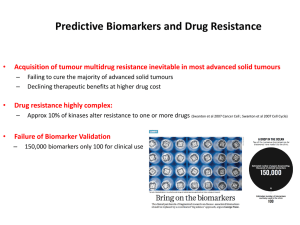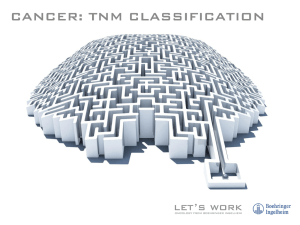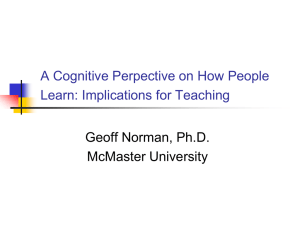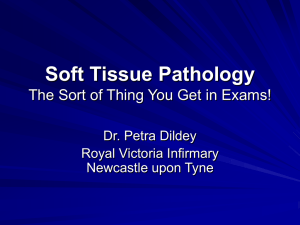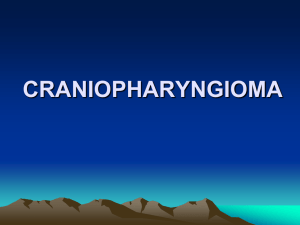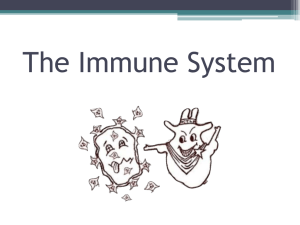presentation source
advertisement
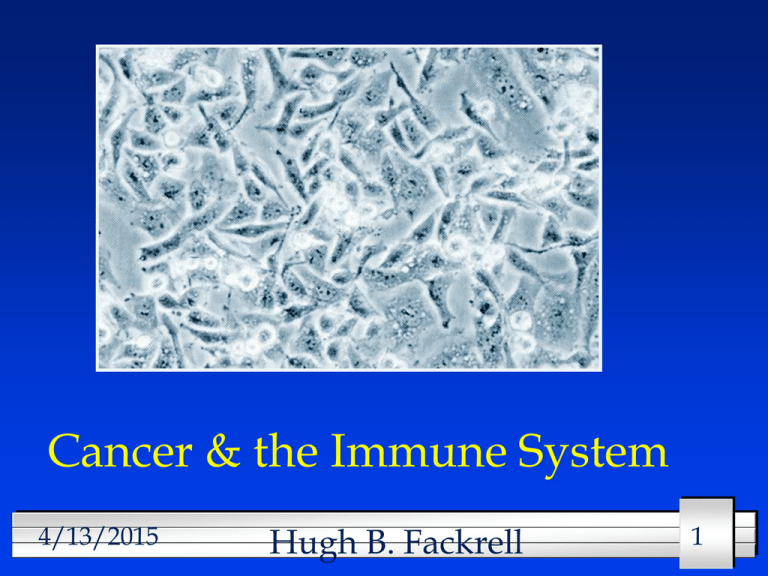
Cancer & the Immune System 4/13/2015 Hugh B. Fackrell 1 Cancer & the Immune System Assigned Reading Content Outline Performance Objectives – Key terms – Key Concepts Short Answer Questions 4/13/2015 2 Assigned Reading Janis Kuby’s Immunology 4th Ed Chapter: 22 pp 539-561 Janis Kuby’s Immunology 3rd Ed Chapter: 24 pp 573-596 4/13/2015 3 Content Outline Origins & Terms Malignant Transformation Tumours of the Immune System Tumour Antigens TATAs on human melanomas Immune Response to Tumours Tumour Evasion of Immune Response Cancer Immunotherapy 4/13/2015 4 Origins & Terms 4/13/2015 5 Benign vs malignant 4/13/2015 6 Distribution of Cancer 4/13/2015 7 Diameter of Tumour (mm) Growth of Breast Cancer Death of Patient Tumour first palpable Tumour visible by X rays 1012cells 109cells 108cells Tumour Cell doubling 4/13/2015 8 Altered Growth Properties 4/13/2015 9 Localized Benign Tumour 4/13/2015 10 Tumour Invasion of Basal Lamina 4/13/2015 11 Metastasizes to Other Sites 4/13/2015 12 Tumour Antigens Tumour specific Antigens – chemically induced – virally induced Tumour associated antigens – oncofetal tumour antigens – oncogene proteins 4/13/2015 13 TSTA vs TATA 4/13/2015 14 Radio labelled anti CEA 4/13/2015 15 Genes for TSTAs 4/13/2015 16 Malignant Transformation Oncogenes Induction of cell proliferation Inhibition of cell proliferation Regulation of apoptosis 4/13/2015 17 4/13/2015 18 4/13/2015 19 Chromosomal translocations 4/13/2015 20 Tumour Induction 4/13/2015 21 Induction of Tumours 4/13/2015 22 Tumours of the Immune System 4/13/2015 23 4/13/2015 24 TATAs on human melanomas 4/13/2015 25 TATAs on human melanomas 4/13/2015 26 Immunity to Polyoma virus(1) 4/13/2015 27 Immunity to Polyoma virus(2) 4/13/2015 28 Immunity to Polyoma virus (3) 4/13/2015 29 Immunity to Polyoma Virus (4) 4/13/2015 30 Immune Response to Tumours NK cells & macrophages Immune surveillance theory 4/13/2015 31 4/13/2015 32 4/13/2015 33 Tumour Evasion of Immune Response Immunologic enhancement Modulation of tumour antigens Reduce MHC-I No co-stimulatory signal 4/13/2015 34 4/13/2015 35 4/13/2015 36 Tumor Escape 4/13/2015 37 Cancer Immunotherapy Modify Co-stimulatory signal Enhance APC activity Cytokine therapy MABs Tumour cell vaccines 4/13/2015 38 Cancers Treatable by Bone Marrow Transplants Allogenic/syngenic Transplant – – – – – – – – – Breast cancer aplastic anemia leukemia ALL CML Myeolodysplasia multiple myeloma Non- Hodgkin’s lymphoma Hodgkin’s disease 4/13/2015 Autologous Transplants – – – – – – – – – – – Leukemia AML ALL Multiple Myeloma Non Hodgkin’s lymphoma Hodkin’s disease Solid tumours Breast ovarian testicular Neuroblastoma 39 4/13/2015 40 Transfect co stimulartory signal 4/13/2015 41 Transfect with GM-CSF 4/13/2015 42 Lak cells & IL-2 4/13/2015 43 Mabs to B cell Lymphoma 4/13/2015 44 Tumour Cell Vaccine Immune Response to MCA or PV Transplant killed cells of MCA induced sarcoma A Challenge with Sarcoma A- No Growth Challenge with Sarcoma B- growth 4/13/2015 Transplant killed cells of Polyoma Virus induced sarcoma A Challenge with sarcoma A no growth challenge with sarcoma B no growth SV40 induced sarcoma C- growth 45 4/13/2015 46 DONE!!! 4/13/2015 47 4/13/2015 48 4/13/2015 49 4/13/2015 50 4/13/2015 51 4/13/2015 52 4/13/2015 53 4/13/2015 54 4/13/2015 55 4/13/2015 56 4/13/2015 57 4/13/2015 58 4/13/2015 59 Performance Objectives 4/13/2015 60 Key Terms antibody dependent cell mediated cytotoxicity (ADCC), benign tumour, cancer, carcinogens, proto oncogens, immune surveillance, Specific immunotherapy, non specific immunotherapy, immunotoxins,Lymphokine activated killer cell(LAK), 4/13/2015 61 neoplasm, oncofetal antigens, oncogens, tumour, tumour associated antigens, tumour associated transplantation antigens, tumour specific antigens, tumour specific transplantation antigens 4/13/2015 62 Key Concepts Differentiate between a benign tumour and a malignant tumour. Describe the concept of immunosurveillance Describe the different ways that tumours can camouflage themselves to evade immune defenses, Discuss the advantages of immunotherapy over other forms of cancer therapy. 4/13/2015 63 Distinguish between specific and nonspecific immunotherapy with the use of specific examples. Describe immunotoxins. Describe the development of humanized antibodies to tumour antigens Evalulate the contribution of T cells, NK cells, Macrophages, and B cells to tumour immunity. 4/13/2015 64 Distinguish between tumour specific transplantation antigens and tumour assoicated transplantation antigens. Describe oncofetal antigens. 4/13/2015 65 Short Answer Questions 4/13/2015 66 Explain how some cancer cells that can make TGF-beta are immunosuppressive. Tumours and transplants are similar to one another,yet very different. Explain this observation in the context of what the immune system recognizes and the result of this recognition. The qualities of proliferation and differentiation are essentially all that distinguishes a normal cell from a cancer cell. Explain. 4/13/2015 67 Design an experiment using mice that proves that the immune system provides immunity against tumours. Distinguish between tumour-specific transplantation antigens (TSTA) and tumour associated transplantation antigens (TATA). Design an experiment to show Tumour associated Transplantation Antigens (TATA). What is the main difference separating cell surface antigens from chemically induced and virually induced cancers? 4/13/2015 68 Speculate on why this difference leads to difficulty in designing anticancer vaccines. What are oncofetal antigens? Are they important in tumour immunity? Why? What is immune surveillance? All evidence for immune surveillance is indirect. Speculate on how you could get direct evidence. 4/13/2015 69 What immune cells play a role in tumour rejection? Briefly describe how each accomplishes this task. Include such things as cytokines, perforins, ADCC etc. Cancers camouflage themselves to evade antitumour defenses. Pick three possible forms of camouflage that you think are most important, describe them and state why you think they are most important. What are immunotoxins? 4/13/2015 70 Surgery, radiation and chemotherapy are the methods most widely used to treat cancer patients. What are the problems with this regimen, and how could immunotherapy overcome these problems. Distinguish between specific and nonspecific immunotherapy. 4/13/2015 71


